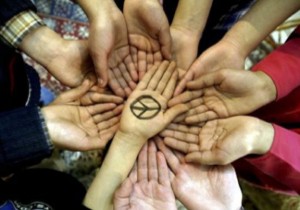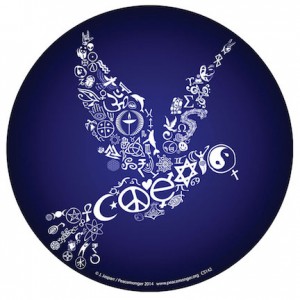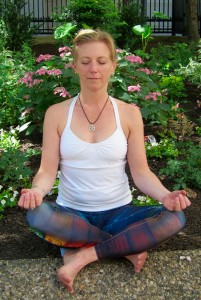June 21, 2021
We have just heard that the Philadelphia Police Department is going to send out our Peace Day activities for youth to all districts in Philadelphia. Community Relations officers for those districts can then plan something meaningful in their community related to peace for September. It is a fact that, when officers interact with their communities in positive ways, when do crisis happen there is greater familiarity – and even some measure of trust. There is no other Police Department nationwide that makes this commitment. The Philadelphia Police Department has been involved in Peace Day Philly since its first year, 2011 (except for 2020 – COVID).
May 21, 2021
Excited to have our first meeting with School District contact to brainstorm how the District can be involved this year. We are working on a central event and possibly some on-line events. Also, we will be able to share our Peace Day Philly activity suggestions from K-12 with schools.
May 4, 2021 – Interview with Peace and Love Amplifiers – CLICK HERE
January 2021: During its first ten years, Peace Day Philly has always emphasized its founding mission: Empowering all people to collaboratively build a more peaceful and just world.
Communities of color, especially African-American communities, are deeply suffering as they face violence, injustice, lack of access and inequality. This cannot stand. We must work together to take on and dismantle racism when and where we see it, and work toward more just, united, healthy, and peaceful communities. We all suffer when racism exists.
We applaud the many Philly organizations that are finding ways to create interactive, meaningful programming at this critical time. We welcome collaborators for future programs. Our sincere thanks to all who are helping others out there, even at risk to their own health.
Peace Day Philly will continue to stand against racism and for greater safety, justice and peace in Philadelphia communities and beyond.
August 16, 2019
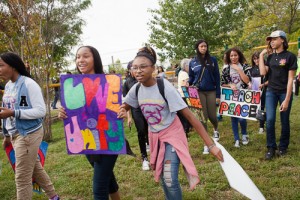
One month to Peace Day! It’s hard to believe. We are very excited about the programs we are offering for this year related to global, local and personal peace. We are also excited that this year the Philadelphia School District is on board with Peace Day. They have been sharing peace activity ideas in schools throughout the district and will hold a special “Take Action for Peace” event during the week of Sept. 16. 200 students are expected to attend this event which will include panel, performance and tabling related to peace and well-being. Chicago’s Build the Peace has involved their public schools for year, and we’re really happy that the Philadelphia SD is joining in this year.
Parkway NW High School for Peace and Justice will hold a march and program in mt. Airy/Germantown during the week of Sept. 16. Parkway has been a stand out in terms of their engagement in Peace Day and we congratulate them on all they do to engage the students in peace activities during that week.
The Philadelphia Police Department will again organize peace activities in districts across the city, This is a unique effort nationally and internationally. The PPD started working with PDP in 2011.

Hibiscus image used with permission c. 2018 by Sara Steele, All Rights Reserved.
September 16, 2018
Guest Blog for Artist Sara Steele: Thoughts in Preparation for Peace Day
Peace Day Philly (PDP) encourages action for peace on personal, local and global levels in observance of the United Nations International Day of Peace, September 21. While all levels of peace are extremely important, we, the PDP leadership, believe that personal peace is the most essential level to cultivate.
It’s only been recently that I’ve been able to consistently access peace within myself, despite eight years spent leading an organization that promotes personal peace as essential. It’s taken a lot of support and practice for me to be able to do this, and I don’t always succeed, particularly when interacting with others under the sometimes stressful conditions of organizing PDP. My failures related to others are the ones I most regret, and I work to make amends for my mistakes. In the absence of forgiveness from others, it’s important for me to work on forgiving myself, and to learn from those situations for the future. My old habit was to beat myself up when I made a mistake, especially as we came closer to Peace Day.
One key way I practice maintaining my peace is to act from a place of intentionality rather than one of reactivity when negative emotions, circumstances, and tumbles invariably arise. I choose to tolerate negative feelings directed my way, to practice getting calm and to resist old habit patterns. I have to transform my internal habit of blame and shame, and while at times I need the understanding of others, I need to be understanding toward myself even more.
It’s easier to see violence externally on local and international levels. It’s more a bit more slippery to face the violence we can inflict on ourselves. If we truly want a more peaceful world, this is where we need to begin: decreasing self-violence, increasing internal well-being, and consistently practicing. Take a few minutes of space. Remember to breathe. Practice mindfulness. Schedule self-care. Do your best and don’t get attached to the result. Notice what you’re doing well. Focus on sharing compassion and loving kindness with others, especially during challenging moments.
This year, I am committing to creating greater internal peace. This in turn will allow me to create more positive, connected, enriching moments during PDP, for myself and for others, that are truly in the spirit of peace.
–Lisa Parker, Co-Founder
August 29, 2018
Reflections on the Peacebuilding Process – Part 3
Peace Day Philly has only come this far because people and organizations have said “yes.” We are now in our eighth year, and though I still lack comfort in the role of leader at times, when someone offers help or kindness it helps me to re-connect to the inspiration that got us started in the first place. This idea of a worldwide day of peace. A global day of local opportunity. A Peace Day for the broken and beautiful city that I’ve lived in most of my life.
It’s especially meaningful when women in my orbit offer to help. They have their own projects and priorities, yet they take time to find where they can help support our mission. They offer optimism as I move toward the date PDP starts, helping me, with their generosity, to wrangle my anxiety about having no one show up for the PDP programs we have carefully crafted. They remind me to breathe and keep my focus on what we are working to do —to offer new skills, new knowledge and new perspectives that help create a more peaceful world.
On the other side are those that could help, but say no. Those with whom I feel I am trying to sell the idea of peace rather than having them see the value of this platform straight away. I’ve tried to get the school district on board. For years. I’ve tried to get press and media to take notice of what we are doing. Rarely am I successful. There are moments after these “nos” when I wonder why I do this work. What is it worth? What impact does it have?
And then I interact with someone who says “yes.” Who is interested in Peace Day and gets the opportunity it holds. Gets it without me explaining it. Without me selling it. And then I feel heartened. That Peace Day can mean something to those who choose to see its meaning. That we can effectively help people plug in to the day with ideas and resources and programs. I am so thankful for my team, a small group of committed people who have said “yes” for years, even with my limitations and failures. They make it possible to continue, as do those across the city and beyond who answer my emails, calls and invitations to use Peace Day as a day to increase consciousness about and action for peace. –Lisa Parker, Co-Founder
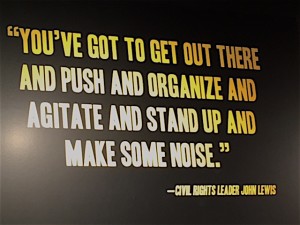
August 11, 2018
Reflections On the Peacebuilding Process – Part 2
One of the things I try to emphasize when talking about Peace Day is that, while the day we share across the planet with all humanity is deeply powerful, the impact Peace Day can have both before and after the day can be very powerful, too. The collaborative planning process in itself is a peace process, and the relationships formed, as well as shared experiences and growth, can mean a positive impact far beyond the day.
Now, August, is the time for differences of opinions and perspectives to become more intense. It seems a natural part of the process in putting events together. So when do we speak up about something, and when do we listen/go with the group? When is it constructive to push? When is it too late to push? When is it truly about something essential to the program, and not just our bias and preferences creating the desire to speak up?
If a goal we have is not getting met, can we let it go of it in the name of maintaining harmony, or is the goal worth standing strong and speaking up for? If it is, how do we do this in a way that is still within the bounds of peaceful and constructive communication and organizing? Can we risk not being liked, at least momentarily, as well as the inconvenience and discomfort that our standing up may cause? Compromise is essential to the peace process, but cannot be made to the detriment of the program/activity that is being planned.
Lately, civil rights activist Congressman John Lewis has been using the hashtag #goodtrouble. This concept of #Goodtrouble has been absolutely essential through history for social justice to be forged. I have begun to think about it as a way of evaluating whether what I am pushing for makes sense given the context and other people/organizations involved. When is it time to make #goodtrouble, and when is the time to let go in order for the process to be a positive and peaceful one? Disagreements are always risky, but if they can be worked through constructively the relationship can strengthen as a result. And avoiding the conflict, in my experience, has generally resulted in relationships/connections ending after the collaborative event is over.
Like many people, I never really learned the skill of disagreeing without being at least somewhat disagreeable, or the skill of standing up for my vision/goals in a constructive way. Peace Day Philly has taught me a lot about that, especially in times where I have failed – and failed big. Sometimes the depth of my mistakes have made me want to walk away from PDP. Yet my regret can only be meaningful if I allow it to positively inform present activities, and if I use my failures to help me make better judgements in the present. That is is a lesson about which I need to be ever mindful.
Here’s to continuing to learn how to make #goodtrouble.
– Lisa Parker, Co-Founder
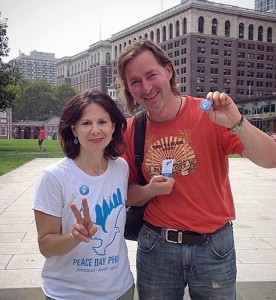
July 27, 2018
Reflections On the Peacebuilding Process – Part 1
Sometimes, building peace is hard. At times it is difficult to find the way to collaboration through different agendas, perspectives and working styles. Peace Day Philly, though, has always preferred creating collaborative events. Both the process and the result are generally much richer and more meaningful than independent programs.
In my experience, all parties need to have a level of trust with one another to move through the trips and traps that can arise in the process. Sometimes building that trust takes a little time, though the realities of time and schedules can make that challenging. In addition, all groups need to respect one another and the expertise that they bring to the table.
Without trust and respect, the process is generally negatively impacted and conflicts and misunderstandings can easily arise. At those times, I believe that the process needs to pause in order for the trust and respect issues to be addressed openly and, hopefully, a greater understanding and plans for a unified direction reached. When that does not happen, the energy around an event can become negative, even destructive, and the result does not at all reflect the original intention for peace and harmonious relationship or the spirit of the International Day of Peace.
I’ve also found myself in the middle of two organizations, feeling pushed by the needs of both sides and in between what each side feels is important. Sometimes I have not been able to make both sides satisfied with planning choices. That is hard for me. I don’t like to disappoint or have discord in the PDP planning process. But sometimes these decisions need to be made. Then it again comes back to trust. Trust that everyone is doing the best that they can, and some solutions are imperfect. Or, at times that means people, including me, rethinking agendas and being open to exploring a more wholistic perspective. Even seeing an opportunity in a time of struggle. It absolutely means attempts at good communication for the goal of greater understanding. Within that framework, compromise can far more easily be reached.
I am not a trained peacebuilder. I am a social worker by training. I can be highly emotional at times, and when the stress of multiple days of events bubbles up, I have trouble maintaining my personal peace. I have made many mistakes in the process, but each year I try, as one of our founding members said, to “Build Peace In Peace.” This is one of the reasons Peace Day – the International Day of Peace – is so profound and impactful. It is not all about what happens on September 21, but the peace processes that take place before the day – and what can unfold as a result of collaborative action on the day.
— Lisa Parker, Co-Founder
“Differences are not intended to separate, to alienate. We are different precisely in order to realize our need of one another.” – Desmond Tutu
Our current social, political and environmental climate can cause us to feel more pessimistic than ever. So how can one day even begin to make a dent in the many issues and local/national/world events impacting peace on personal, local and global levels?
The United Nations International Day of Peace (“Peace Day”), September 21, is an opportunity for people, organizations and governments across the planet to focus awareness on, and take meaningful action for, peace. In a number of world cities, like Philadelphia, peace activities take place throughout a full week around September 21. As the organizing process begins weeks or months before the day, ofter involving new collaborations, and the impact on thought and action as a result of participation in programs spans well after the week is over, Peace Day has the potential to be so much more than one symbolic day.
The UN has many annual days of observance, yet none have inspired and involved “civil society” worldwide – that is, people and NGOs – as Peace Day. Individuals with no prior peace organizing experience have created and cultivated initiatives in their cities as a result of seeing the potential and power of the day. Icons like Dr. Jane Goodall, a UN Messenger of Peace who inspires youth worldwide, urges people of all ages to use Peace Day as an opportunity to help people, animals and the environment. In a time where more and more ordinary people are now marching, writing their congress people and speaking out against prejudice and injustice, Peace Day is a powerful platform to learn new peacebuilding skills and to take meaningful action for a more peaceful world.
Peace Day Philly’s website focuses on the WHAT CAN YOU DO? section, providing ideas and resources for engaging in Peace Day on personal, local and global levels. Pages in this section relate to youth, the arts, the environment, intercultural/global, nonviolence, health, spirituality and faith, social justice and more.
For those who want to engage in the day/week without organizing something, Peace Day Philly will be presenting a number of content rich programs – almost all free – as well as those with a strong multicultural aspect for PDP 2017:
-“Mindful Activism” will focus on how we can be effective change makers even when interacting with those whose views we might find disturbing
– The “Interfaith Ally” workshop will teach skills in being an Upstander rather than a bystander in the context of faith when racism occurs
– A “Dialogue Across Difference” training will involve dialogue skill building within the current context of polarization
– A program about migrants globally and locally will present information within the current national anti-migrant atmosphere
– A film about climate change with a facilitated discussion will help raise knowledge of the issue
– A talk on Mindful Activism and Peace will encourage looking at peace from the inside
– A workshop on “Recognizing and Interrupting Racism” in the wake of Charlottesville
– A talk on global peacefulness, including the impact of the refugee crisis
– Youth and staff training in 2 inner city schools on how to be an “Upstander” (grant supported-closed activity)
Multicultural programs during Peace Day Philly will include:
– A day of multicultural activities at the Reading Terminal Market, including a multicultural mural-making project involving the public and multicultural performances
– Children making peace cranes at various schools and other settings that will then be shared with children in another part of the world
– Exhibitions and workshops related to Iraq and Syria
– An arab culture celebration
There will be opportunities to gather in unity and celebration, too:
– “Peace and Love Concert” with jazz ensemble the Jost Project – September 17 at the Phila. Ethical Society
– “Together for Peace” Peace Day Philly 2017 – Sept. 21 in Rittenhouse Square
– 7th Annual Sing Along for Peace outside the Philadelphia Ethical Society
– “Together for Peace” Concert featuring Farah Siraj, Jordan’s musical Ambassadress and humanitarian as well as songwriter Ben Arnold
Ultimately, the power of Peace Day is determined by all of those who choose to engage in it in a way that they find meaningful. Even if the action someone takes on Peace Day is as simple as observing a minute of silence at noon (an activity that takes place across the world in all time zones), that can be a powerful act toward a greater consciousness about peace. To see Peace Day as a beginning, rather than as one fleeting day, is to extend its power into the days far after September 21. And if ever there was time to embrace our power to extend consciousness about and action for peace, it’s NOW.
A final note:
We are so very grateful to our supporters – the Spruce Foundation, the Philadelphia Rotary Foundation and individual donors – as well as to collaborating and/or presenting organizations (full list HERE) like the Philadelphia Ethical Society, the Philadelphia Police Department, Dialogue Institute, the Interfaith Center of Greater Philadelphia, the Peace Center, Penn Global, The Penn Museum, American Friends Service Committee, Amnesty International, the City’s Department of Behavioral Health, and others. These people and organizations have helped make so many rich events for peace and unity possible this year.
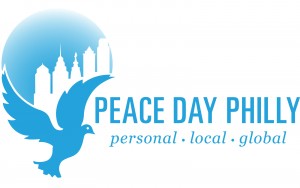
September 15: Guest Blog – On The Bright Side – Why I Support Peace Day Philly
Why should we look into the potential of the systems thinking and positive peace? Looking at the bright side of the world does not mean ignoring the dark side, but accepting the ambiguity, suspension of immediate rewards, and holistic understanding of the systems that sustain our attitudes.
By Mariko Siegert
If we meditate on the idea of ‘peace’, we may think of something utopian and/or harmonious – without starving children, people packed on a boat in the middle of the ocean, airstrikes, bullet holes in the wall of schools, sounds of gunfire, physical and sexual exploitation, and so forth.
Yet precisely because of those these harmonious images of an ideal world, some people may have given up on peacebuilding. When we look around, the world looks far different.
“Is world peace attainable?” “Do you really think it is possible?” “I think you are wasting your time.”
I do not know how many times people I was just getting to know have questioned my passion for global peacebuilding efforts. It is true there has not been a single day in my life (at least as far as I can recall) that I did not hear of someone suffering. Human suffering is too ubiquitous.
Norwegian peace researcher Dr. Johan Galtung stated in his Violence, Peace, and Peace Research (1969) that the idea of peace should begin with the following three principles:
- The term peace shall be used for social goals at least verbally agreed to by many, if not necessarily by most.
- These social goals may be complex and difficult, but not impossible, to attain.
- The statement peace is absence of violence shall be retained as valid.
What does this mean? Dr. Galtung holds the belief that violence, even on the individual or interpersonal level, is embedded in the social system; thus it is more appropriate to consider peacebuilding as a social goal, without placing the responsibility solely on individuals. Violence researchers (note: NOT peace researchers) have increasingly been paying attention to the role of the systems in violence prevention and promotion of human welfare (Chan, Hollingsworth, Espelage, & Mitchell, 2016; Howell et al., 2016; Institute for Economics and Peace, 2016; Shaw, McLean, Taylor, Swartout, & Querna, 2016). Galtung also stresses the importance of staying realistic and focused on problem-solving of today’s political, intellectual, and scientific agenda (Galtung, 1969).
We can break this down to say, that peace is a shared goal of today’s society that requires systemic problem-solving and social change. Dr. Galtung is the one that proposed the concept of structural violence–any avoidable human suffering is a form of violence. For example, deaths from tuberculosis in most of the high-income countries today is a form of structural violence but it was not in the 1930s.
When we say we want peace, we are not necessarily being delusional or envisioning a utopia. We may mean that we do not want to witness human suffering, or we may also mean that we want to see more happiness. The point here is that we probably do not think of peace in an ‘all-or-none’ fashion, but rather, our desire is to move closer to the state of positive peace (i.e., “the attitudes, institutions and structures that create and sustain peaceful societies”; Institute for Economics and Peace, 2015, p. 7).
So, is the world peace attainable?
I would say yes — it is attainable, but may take generations or even centuries. It may even have to be built upon shared compromises. This means that we may not ever achieve the perfect form of positive peace. This certainly sounds rather passive and not ideal. If we try to build the system that sustains peaceful societies, however, the realistic and attainable, and widely agreed-upon, image of peace is not a utopia. Peace is built on the respect for others’ rights. By creating a culture, or systems, that respect others’ rights and encourage us to be patient and cognitively flexible, I imagine it would become more difficult to focus on the negatives in our lives and the world and become easier to focus on problem-solving.
This is definitely one of the many reasons why I support Peace Day Philly. It is a local initiative dependent on collaborations among groups, organizations, and participants with diverse backgrounds, beliefs, and orientations. This is a grassroots effort to create a culture of peace.
References
September 9: Guest Blog – Changing the Subject: Harnessing the Power of Art and Storytelling in Peacebuilding
Peace Day Philly features photographs, paintings, and stories by Syrian refugee youth this year. Art and storytelling are effective means for cultural change. On September `8 at 5:30pm, Philadelphia resident Greg Shaheen presents children/youth works, video footage, and his experience working with a Syrian refugee community in Lebanon.
By Mariko Siegert
Art and storytelling are powerful tools for cultural change, on which peacebuilding efforts are built. Some Philadelphian may recall an art exhibition at Haverford University held last fall, Testimonies in Arts & Action: Igniting Pacifism in the Face of Total War. There have been a great number of art exhibitions across the country and globe on the theme of conflict, war, and peace. The Visions of Conflict Art Exhibition held in Dayton, Ohio last fall posed a question to the audience through testimonies, sharing of firsthand experiences of war, and artworks created through the memories: What is your understanding of war?
The small portion of the world’s population that has never experienced or witnessed the cruelty and aftermath of war, including myself, would benefit greatly from exposure to these cultural artifacts in contemplating what our lives are built on, how “we” matter to “them” and vice versa, and what we could do so that the peace that we enjoy can be a story that they will be telling. By the way, according to Uppsala Conflict Data Program, in 2014, there were 40 conflicts worldwide, 80% of which occurred in Africa, Middle East, and Asia where over 75% of the world’s total population lives (Population Reference Bureau, 2014). Our stories have intergenerational effects–the story we tell today may be passed on to many generations to come.
Foster, Horowitz, and Allen (2016) contend that it is necessary that the society is radically restructured in order to build sustainable peace globally. I believe the radical social, or cultural, change, although this term may sound too extreme and may face resistance, could start with some simple steps–with our “changing the subject”–from the subject we look away from or the story as we understand it to the subject and story as experienced and told by those who have experienced them. By immersing ourselves in their stories, we are able to experience and live them, cultivating empathy and sharing the desire for peace.
The Peace Day Philly program “We Grow Where We Are: Photos, Paintings, and Words by Syrian Refugee Youth” will take place on September 18, from 5:30 p.m. – 8:00 p.m. Artworks will be on sale and all the profits will be donated to refugee communities. Please come join us to learn the stories of Syrian refugee youth.
References
Foster, J. A., Horowitz, S. M., & Allen, L. (2016). Changing the subject: Archives, technology, and radical counter-narratives of peace. Radical Teacher, 105, 11-21.
Population Reference Bureau. (2014). 2014 world population data sheet. Retrieved from http://www.prb.org/pdf14/2014-world-population-data-sheet_eng.pdf
Uppsala Conflict Data Program. (2014). Armed conflict by region. Retrieved from http://www.pcr.uu.se/digitalAssets/66/66314_1armed-conflict-by-region-1946-2014.pdf
September 4: Guest Blog – Faith Matters: An Interfaith Peace Dialogue How is peace achievable through interfaith dialogue? How does it construct a shared truth beyond human differences?
By Mariko Siegert
An Interfaith Peace Dialogue will again be a Peace Day Philly program. This year, it takes place on September 18 at 2:00pm with the theme “Welcoming Each Other Across Diverse Cultures & Faiths.” It has become easier to have international experiences–over the Internet, through international travel, personal interactions with international tourists, students, and workers. This can be exciting–or unsettling. In this blog post, I will first introduce some findings on how we perceive cultural difference, moving onto the importance of faiths, and finally, reflect on how interfaith dialogue can be useful in creating peace.
Cultural Difference (Thatcher, 2013)
Each of us carries a blend of cultures, or worldviews. How are our different cultures interact with each other when we experience ‘cultural diversity’? This depends on the situation. For example, in workplace, diversity in knowledge can lead to positive outcomes, but racial or gender diversity often has negative outcomes. While this type of ‘easily visible’ demographic diversity is typically a factor based on which separation/group is formed, this separation may quickly be overcome through collaboration. Diversity in value can often be a strong underlying motivation of group formation, but not as strong as visible diversities. This line of research is called ‘demographic faultline research’, of which the purpose is typically to use the knowledge about our perception of human difference, group dynamics, and social categorization to enhance the quality of organizational collaboration and performance.
The Importance of Faith
So, difference in value can strongly motivate us to either exclude or include others. Faith is a component of the value, on which we often subconsciously develop expectation for others, and moral frameworks and standards. This can, in turn, legitimize retaliation or animosity toward the different others, while helping us form solidarity and a sense of belonging with the similar others. Numerous studies in social psychology have found that we tend to think the similarities are larger among the members of the same group than they actually are, and feel less ‘connected/relatable’ to the members of other groups (Tajfel & Turner, 1986). In addition to the value differences, on which people may not want to compromise, different group membership and social identity could hinder us from seeking intergroup understanding.
Why Interfaith Dialogue?
Interfaith dialogue, however, can result in openness, interpretation, understanding, and truth because it is a conscious effort to go outside of one’s own comfort zone to talk and listen to the differing others. When we listen to others, we interpret what they say through our own lens (e.g., experiences, values, beliefs, etc.), and create a new understanding of others and ourselves. This, then, becomes a shared ‘truth.’ Interfaith dialogue is easier to be said than done, and it will require deep identification with the others to create compassion and empathy. To quote Michaelides (2016), in a way, this is a practice of faith–‘faith in others’–that can be practiced by anyone. If some of the conflict around us is caused by divisiveness and lack of intergroup understanding, then we may get closer to the resolution of conflict through our conscious effort to practice our faith in others and engage in an interfaith peace dialogue.
An Interfaith Peace Dialogue: Welcoming Each Other Across Diverse Cultures & Faiths – Sept. 18, 2pm, Philadelphia Ethical Society. co-presented by Philadelphia Ethical Society, Dialogue Institute, Interfaith Walk for Peace & Reconciliation and Peace Day Philly.
All faiths and practices welcome! Refreshments and networking after the program at 4pm.
References
Michaelides, P. E. (2016). Cultural interdependence and the ethical other: Hermeneutical openness in interreligious dialogue and the common effort to address pressing global issues. International Journal of Arts & Sciences, 9(1), 279-296.
Tajfel, H., & Turner, J. C. (1986). The social identity theory of intergroup behavior. In S. Worchel, & W. G. Austin (Eds.), Psychology of intergroup relations (pp. 7–24). Chicago, IL: Nelson-Hall.
Thatcher, S. M. B. (2013). Moving beyond a categorical approach to diversity: The role of demographic faultline. In Q. M. Robertson, The Oxford handbook of diversity and work (pp. 52-72). New York, NY: Oxford University Press.
September 2: Guest Blog – Yoga and Meditation: Peace with the Self
Yoga for Peace and Meditation for Peace programs will take place during Peace Day Philly this year. Find, create, cultivate, and practice peace with the Self.
By Mariko Siegert
Peace Day Philly is excited to have Yoga for Peace (including vinyasa yoga, meditation, Drum Circle, and Feast for Peace) on Sunday, Sept. 18 and Meditation for Peace on Tuesday, Sept. 20.
More and more people in the U.S. and around the world are appreciating and practicing yoga and meditation now, but what are they, really?
I would like to introduce a couple of quotes:
“This world is your body. This world is a great school. This world is your silent teacher.” – Swami Sivananda, Yoga Master
“Meditation practice isn’t about trying to throw ourselves away and become something better; it’s about befriending who we are.” – Ani Pema Chodron, American Tibetan Buddhist
According to Lateef Warnick, yoga means ‘union’ between the Self and God/Higher Power, and activities to obtain this union, whereas meditation, derived from the word ‘dhyana’, means awareness or consciousness, and is the seventh step (out of eight) of the yoga practice. Warnick suggests yoga has an emphasis on the ‘doing’ and meditation on the ‘being.’ The ultimate goal of yoga (and meditation) is for one to find the union, learn to control life force (both external and internal) through acceptance of, and peace with, the Self and the present situation.
We worry–it is hard not to worry. A poll by the American Psychological Association (APA) in 2014 found that over 64% of the respondents worried about their financial issues, followed by work (60%), family responsibilities (47%), and health concerns (46%), with 1 out of 4 experiencing ‘extreme stress’ over their financial concerns and 3 out of 4 worrying about their finances ‘some of the time.’ APA says that one of the most commonly used coping methods is ‘talking with friends’ but sometimes, you may feel bad for turning to them, or they may not be available. Learning and practicing yoga and/or meditation can help you attain better balance and empower you to be more peaceful – toward yourself and in relationship with others.
Said Sarah Murphy of Transformative Therapy, Lead Organizer for the Yoga for Peace event: “Practicing yoga has been invaluable to me and thousands of others in learning who I am, and who I am not. I am not my thoughts; I am not my feelings; I am not my body. For many of us, the yoga mat is the place where we first learn to quiet our minds. On our mats we learn to observe our reaction to challenging situations and to detach from those reactions. The mat is both a metaphor and a training ground for life”
You can learn more about yoga and meditation, and how to practice them, during PDP this year. Both events are free. Mark your calendar, bring your friends, family, or simply yourself (and yoga mat for yoga).
Sunday, Sept. 18, beginning at 10am – Yoga for Peace (includes drum circle, vinyasa yoga, meditation and Feast for Peace – come to some or come to all.)
Tuesday, Sept. 20, 6-8pm Meditation for Peace (guest speakers/facilitators will be a mindfulness practitioner and practitioners of 2 different buddhist faiths)
For the full PDP 2016 schedule and event information, click here.
______
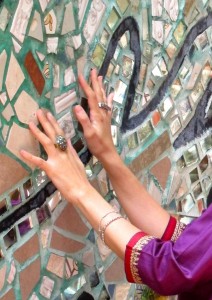
August 30: Guest Blog – Mosaic Peacebuilding – Peace Day Philly Core Team
Manisha Patel, Hugh Taft-Morales, Frank Neil, Tom Di Nardo and Lisa Parker discuss the values of collaboration, inclusion, and respect in peacebuilding and their work as PDP Core Team Members.
By Mariko Siegert*
I think that each individual can be a culture with his/her own histories, identities, beliefs, and values. We know and have seen that cultures can clash, but that they can also coexist, complementing and strengthening each other. Today, five of the PDP Core Team members–each with different backgrounds–share their thoughts on peace and PDP.
How would you define peace?
Manisha: A place full of calm that is in harmony with others.
Frank: As a zen practitioner, I believe that peace can be defined as “just this” – all that you could possibly need is contained in this moment. More broadly, peace is everyone in the world being satisfied with what they have and allowing others to live their lives without intrusion, violence or the need to control.
Tom: Not just the absence of violence, but the intention of equality, opportunity and freedom for everyone, everywhere.
What got you into peace related work?
Lisa: I learned about the International Day of Peace, and I was inspired to begin encouraging everyone to use the global day as a day of local opportunity and action.
Frank: The need to do something, however small, to help highlight the need for the peaceful co-existence of all people.
Tom: A Quaker educational background, and the inspiring dedication of the volunteer team.
Why were you interested in being a part of Peace Day Philly, and what makes Peace Day Philly important?
Hugh: All my life I have been aware of how lucky I am to live in relative peace. For so many, however, peace is illusive. Peace Day Philly is a time to draw attention to those less lucky, whether suffering from gun violence in their neighborhood or being victimized by war in battlefields far away. In some small way I hope PDP leads us all to demand that our leaders nurture peace in all corners of the world.
Manisha: Peace Day Philly initiatives address core issues human beings, communities and world struggle with and so being part of it gives me opportunity to engage others in important work to bring about positive change.
Frank: All things start with the individual. It is important for Philadelphians to be mindful of peace, both in our local community as well as understand how that shapes the entire world.
bLisa: When I see people and organizations being inspired to take meaningful action on Peace Day as I was. We don’t define what the peace activity has to look like – we let the organization choose that based upon their mission and interests.
What has been the most exciting/valuable experience about being a Core Team member?
Lisa: When I see people and organizations being inspired to take meaningful action on Peace Day as I was. We don’t define what the peace activity has to look like – we let the organization choose that based upon their mission and interests.
Hugh: My fellow Core Team Members inspire me to reach out to the international peace community in Philadelphia. So many people from diverse cultural backgrounds are learning how to work together for social justice. Through the arts and dialogue, they bring together immigrants and citizens to find common ground. It helps ground me and encourages me to continue this important work.
Is there any peace message you would like to share?
Lisa: The Dalai Lama said it is our “moral responsibility” to make an attempt at creating a more peaceful world. We must see peacebuilding work as a process and not as an all or nothing proposition. Anyone can be a peacebuilder in their world. We can choose our words and actions, and practice keeping things in perspective so that we do not let emotions overwhelm us. Yet, this is a process, and we’ll fall down a lot as we practice being peaceful within ourselves and with others. We must work to learn from these situations so that they are valuable lessons to us that help guide our future thinking and action.
Frank: “We can never obtain peace in the outer world until we make peace with ourselves.” – Buddha
We tend to develop different personal and social identities and belief systems in accordance with–and in response to–our backgrounds. We develop different lenses to see the world and our own and others’ experiences through. I think we can see how each of these Core Team members approach peace differently, yet with a common goal of building up–ourselves, others, and community, all of which constitute the foundation of sustainable peace. I think that this interview illustrates characteristic of peacebuilding as a mosaic that is collaborative, inclusive, respectful of diversity and ever-evolving. ▉
*Mariko Siegert is a student in the Ph.D in International Psychology program at The Chicago School of Professional Psychology. Her research interests include participatory action research (PAR), peacebuilding in the Middle East and North Africa (MENA) region, policy reform for the Responsibility to Protect (R2P or RtoP) and international humanitarian law (IHL), and ethical humanitarian interventions. She is a member of the Task Force 5 of the American Psychological Association Division 52 (International Psychology) tasked to internationalize psychological disciplines, and to engage more organizations and individuals internationally and domestically in international psychological research and practice.
_____
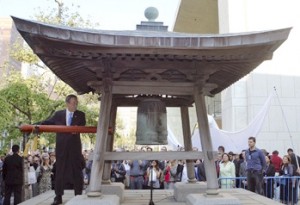
August 27: Guest Blog – Peace: A Universally Shared Local Matter. An Interview with Rev. Deborah Moldow, World Peace Prayer Society and Co-Chair, International Day of Peace Committee at the United Nations. By Mariko Siegert, student in the International Psychology Ph.D. Program at The Chicago School of Professional Psychology.
Peace Day Philly takes place around and on the United Nations International Day of Peace (IDP), or ‘Peace Day’. How will it be celebrated this year, and what does IDP mean to us as global citizens? Why are local peace initiatives, such as PDP, are important in promoting a culture of peace globally? Rev. Deborah Moldow, World Peace Prayer Society and Co-Chair of International Day of Peace Committee at the United Nations explains.
What will happen at the UN for Peace Day?
There will be a very special observance at the UN on September 16th this year, the final International Day of Peace of Ban Ki-moon’s term as Secretary-General. He will ring the Peace Bell as usual, and then move into the student video conference – along with two women Nobel Peace Prize laureates and several UN Messengers of Peace, including Dr. Jane Goodall, Midori and Michael Douglas, who will serve as M.C. There will be a live hook-up to two UN Peacekeeping missions, in Cyprus and Liberia. Students will present their own peace projects and enjoy a rap video on the Sustainable Development Goals, which are this year’s theme as “Building Blocks for Peace.” At 12 noon, Mrs. Ban will ring a Bell of Peace made of recycled weapons of war and lead a Minute of Silence that the students can replicate on September 21st, joining many thousands across the globe.
Why do you think civil society has responded so strongly to a global day of peace?
We are becoming a global civilization, so we need global holidays that we can celebrate together as one humanity. Because the International Day of Peace was established by a UN resolution, it belongs to every nation of the world equally. In addition, a day to celebrate peace reminds us of all the components of a culture of peace that go beyond the cessation of conflict, such as activities for children, faith and/or interfaith services, and concerts, art exhibitions, sporting events, poetry readings, environmental projects and more.
What would you like to share about how initiatives like Peace Day Philly, Build the Peace, Peace Day Austin etc. are raising the visibility of and engagement in the IDP?
Local initiatives for the International Day of Peace such as Peace Day Philly, Chicago Build the Peace, Peace Day Austin and others are tremendously important for building the kind of healthy communities that lead the way to a culture of peace. Everyone can get involved in the celebration. Cities and towns that host such events can not only influence their nations to proclaim Peace Day, but also form a global network of joy and peace.
Most of us are so busy we do not have many opportunities to think about how our lives – what we think and do – is connected to what it happening across the city and across the world. Realizing this interrelatedness beyond the boundaries of time and place, I think, is very important. Globalization has been making our world smaller and smaller for decades, which means many things yet includes greater interconnectedness. Ms. Moldow’s reflection about how Peace Day can be a very meaningful way to embrace the ideals of a culture of peace reminded me of something I have learned: Unless I am able to take good care of myself, I could not think, feel and act compassionately toward others and myself. The International Day of Peace is a wonderful reminder that our lives are part of the global community. ▉
*Mariko Siegert is a student in the Ph.D in International Psychology program at The Chicago School of Professional Psychology. Her research interests include participatory action research (PAR), peacebuilding in the Middle East and North Africa (MENA) region, policy reform for the Responsibility to Protect (R2P or RtoP) and international humanitarian law (IHL), and ethical humanitarian interventions. She is a member of the Task Force 5 of the American Psychological Association Division 52 (International Psychology) tasked to internationalize psychological disciplines, and to engage more organizations and individuals internationally and domestically in international psychological research and practice.

